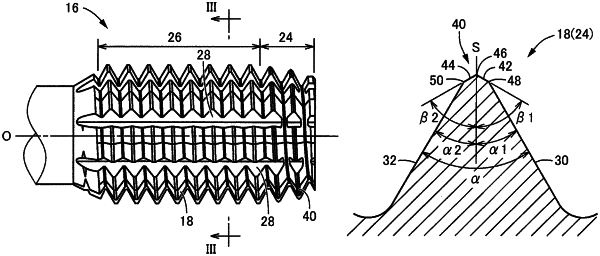| CPC B23G 7/02 (2013.01) [B23G 2200/34 (2013.01)] | 8 Claims |

|
1. A thread forming tap comprising a complete thread portion and a leading portion which is provided to be contiguous with the complete thread portion and which has a diameter reduced in a direction toward a distal end of the thread forming tap, such that the complete thread portion and the leading portion are provided with an external thread in which protruding portions and relieved portions are alternately formed, and such that a thread ridge of the external thread has a cross sectional shape corresponding to a shape of a valley of an internal thread that is to be formed, and extends along a helix having a lead angle of the internal thread,
wherein the thread ridge of the external thread has, in an axial cross section that is parallel to an axis of the thread forming tap, a triangular shape as the cross sectional shape that is defined by a pair of flanks located on respective opposite sides in a direction of the axis, such that each of the flanks is inclined by a predetermined flank angle corresponding to a shape of a valley of the internal thread;
wherein a crest is provided in a top portion of the thread ridge at least in the leading portion, and has, in the axial cross section, a triangular shape that is defined by a pair of side surfaces located on respective opposite sides in the direction of the axis, such that each of the side surfaces is inclined by an inclination angle that is larger than the flank angle, each of the side surfaces extending in a straight line from a corresponding one of the flanks to a top end portion of the crest; and
wherein the inclination angle of each of the side surfaces of the crest is within a range from 40° to 80°, the inclination angle of each of the side surfaces being an angle between (i) a corresponding one of the side surfaces and (ii) a line perpendicular to the axis.
|